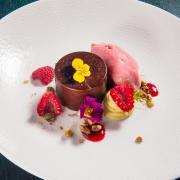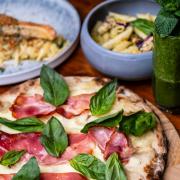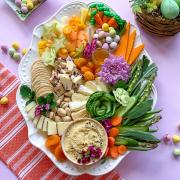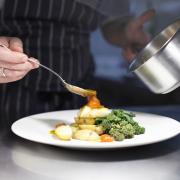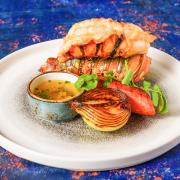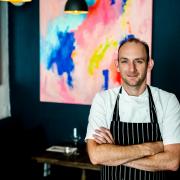Val and John Allen visit Kambuja, where the backstory, food culture and array of dishes are the ingredients for a fascinating and memorable experience.
Kambuja heads up the trio of Stockport-based restaurants that shine a light into the mystique of Cambodian food. The ambassador behind the development of the cuisine in this country is the charismatic chef, creator and businesswoman Y Sok.
Marple, on the edge of the Cheshire Plain, is the discerning host to this delightful café restaurant. Unpretentious and welcoming, the walls are lined with some rather interesting art, which is a direct result of Y Sok's background. Her family fled the civil war in Cambodia in the 1970s to the US where she grew up to become an international fine art dealer. Her mother held the family together in a small community where there were no Cambodian restaurants and very few refugees, so as Y Sok explained, food was the touchstone – a link to the community and the best of a culture she loved. She has sought to recreate that very culture and atmosphere in a menu focusing on and bringing to our attention the areas the Mekong River runs through.
Many good things arise out of adversity, and Kambuja is a shining example of how something can be created when things get tough. Eight years ago, Y Sok's health deteriorated to the point when she had to go on dialysis daily, which made it impossible to continue with her career in the world of art. She opened Angkor Soul with her then-husband, which metamorphosed into Kambuja four years later. She underwent a successful kidney transplant around this time and this enabled her to continue to concentrate on her passion for food. Her restaurants have gone from strength to strength and many eminent food writers have beaten a path to her door.
Heavily influenced by the French colonisation of Cambodia, the cuisine is more complex and subtle than that of its Thai and Vietnamese neighbours. A prime ingredient in Cambodian cooking is a paste called kroeung. Containing lemongrass, kaffir lime leaves, garlic, galangal and turmeric, it forms the base for many of the dishes on Kambuja's menu. The other main constituent is prahok, a fermented fish sauce that dominates the less complex dishes. The menu describes lots of wonderfully unfamiliar offerings so it was my privilege to explore it, from small plates to large, seeking the unusual and delicious in this exciting cuisine.

We started our journey with possibly the best salad combination I have tasted. Angkor salad is popular in Cambodia on special occasions and turns the ordinary into the extraordinary. The shredded combination of the freshest salad ingredients placed on a bed of fine rice noodles, topped with chicken and prawns, sprinkled with deep-fried shallots and freshly roasted and chopped peanuts, finally anointed with a lime and prahok dressing, was a sublime beginning to our meal, awakening the tastebuds with a gentle shake.
We were urged to try the Angkor cauliflower and I'm glad we did as I have recently developed a reluctance to the brassica due to its ubiquity on so many menus. It was lightly battered and tossed in a chilli and garlic sauce. As I bit into the crispy shell and perfectly cooked cauliflower, the succulent sweet and sour sauce was a revelation.
The prawn summer roll had a wonderful crunch of carrot and other crispy vegetables within the transparent wrap and the peanut dipping sauce a great accompaniment. The restaurant sources peanuts unroasted and prepares them as required. It makes a huge difference and contrast to the stale offerings elsewhere.
The Angkor chicken wings were marinated before being lightly battered and dressed with a fabulous concoction of spring onions, chilli and other delights. Another wonderfully sticky sauce anointed them and I was reluctant having to share them with my husband, as I could happily have eaten the lot.

I chose to accompany the meal with an Asahi Super Dry beer and was then lured into a bottle of Chinese-brewed Lucky Buddha, purely for its delightful bottle. There is also a carefully considered wine list with availability by the glass.
The mee broth with prawns and chicken, garnished with bean sprouts, spring onion, fresh coriander, red chillies, deep-fried shallots and lime, was a meal in itself (and is often eaten as such).
The large plates were a joy to behold and taste. Travellers to Cambodia often relate their dismay on tasting the version in this country of fish amok. A native of the Mekong river, basa is a dense and well-flavoured fish that is a revelation when cooked in this way. A creamy, mellow coconut sauce with a layering of flavours consisting of lemongrass, garlic, kaffir lime leaves (also used as garnish), galangal and turmeric, made it a standout and spoke of the French influence on this cuisine.

The loc lac also followed in these footsteps. Generous quantities of tender, marinated cubes of fillet steak are dressed in a lime and black pepper sauce you mix yourself to taste. We passed on the optional fried egg on top on this occasion, but I feel sure it would have been delicious. The crispy ginger tamarind duck sautéed with garlic, chillies, ginger and tamarind, finished with the small but perfectly formed holy basil was a fragrant, beautiful balance between sour, sweet and savoury. The kampot sizzling plate contained one of my favourite things – fresh green peppercorns. Hidden in the other ingredients of pak choi, shimeji mushrooms and oyster sauce, they provide a wonderful explosion of flavour that was perfectly judged. Too many and the effect can be overpowering, too little and it would go virtually unnoticed. The brown shimeji mushrooms added to the layers of flavour and were delicious.

Steamed jasmine rice is included in the price of each main course and is a great foil adding neutrality to the fabulous flavours. There are many more wonderfully authentic noodle and rice dishes, but exploring them will have to wait for another occasion.
We wound up this magnificent feast with two modest desserts. We were tempted by the prospect of apple fritters but contented ourselves with a soothing lime posset with a scattering of gently crushed pistachios and a comforting black sticky rice pudding with a coconut milk sauce.
I enjoyed a pot of jasmine tea with this and was most interested to hear about its preparation, which involves a precise temperature and steeping time, otherwise, there is a danger of burning the delicate leaves and producing an unwelcome bitterness.
There is a rhythm to a meal in Cambodian style. Experienced travellers and diners will know when to order a simple noodle dish and when to order a selection of small plates, or to order larger plates. The convention of starter and main courses can easily be applied to this cuisine – it is up to you to decide what to eat. I would certainly recommend you look carefully at Kambuja's website to research the dishes on offer.
Y Sok's explanation of Cambodian culture and how it breaks down into three distinct hierarchies of eating is fascinating. The working population eat a more highly flavoured rice, noodle and vegetable-based diet with prahok more influential in the seasoning. The middle-classes eat better cuts of meat, fish and poultry and the French influence pre-revolution is key. The meal will be started with the kroeung base – the equivalent of French mirepoix or Spanish sofrito and this is very much the food of Y Sok's heritage, influencing her development and ethos as a chef and restaurateur. The upper echelon – the royal family, the governing and military elite – enjoy a highly labour-intensive cuisine with expensive ingredients. Long infusions, complex preparation, complicated, lengthy processes and sought-after ingredients are the norm.

When we walked into Kambuja, there was a table full of staff enjoying their pre-service meal. The happy atmosphere was very obviously the ethos, and they are all part of what appears to be a close-knit team. Y Sok is, without doubt, showcasing the very best of Cambodia and indeed, the name Kambuja means Cambodia. The food culture the refugees from this turbulent region have introduced, has spread across Europe and the rest of the world, greatly enriching our own culture in the best of ways.
Food ranges from £6.50 to £9.95 for small plates, £16.95 to £17.95 for larger plates, with a £3 supplement for fried rice or noodles.
Beers were £4.50 and wines ranged from £4.50 for a glass through to £27.50 for a Berton Vineyards Shiraz.
Also, The Mekong Cat: 47 Lower Hillgate Stockport SK1 1JQ, 0161 477 6400
Kambuja at the Stockport Produce Hall: 24A Market Place Stockport SK1 1EU, 0161 477 7702
12 Stockport Road, Marple, Stockport SK6 6BJ 0161 222 0707; kambujamarple.co.uk






